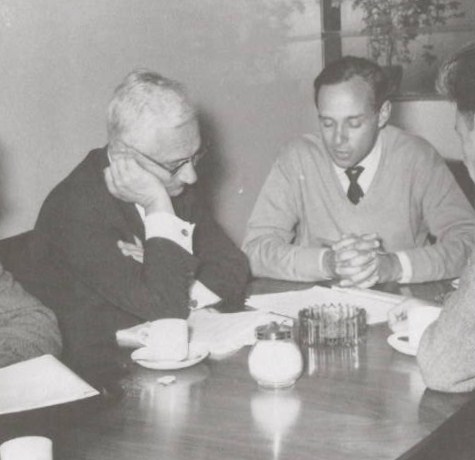
British Medical Journal, November 15, 1958
While updating metadata records in the digitized collection, I came across the name “Alan Goffe” several times. I was interested to learn more about this man who frequently communicated with Dr. Sabin. Luckily, I found a book called, Between Two Worlds: The Story of Black British Scientist Alan Goffe. This book was written by Gaia Goffe, cousin of the late scientist, as a high school project. Later, the book was published by Hansib Books.[1] I found this book to be very interesting because it explains the relationship between Drs. Sabin and Goffe, as well as their shared interest in an oral polio vaccine.
In our collection we have several letters between the two men that discuss poliomyelitis and the B virus. One of the first letters is from Dr. Goffe, asking for strains of poliovirus for use in a formaldehyde treated poliomyelitis vaccine.[2] Of course, Dr. Sabin was willing to provide Dr. Goffe with several of his attenuated poliovirus strains for research. In his letter, Dr. Sabin indicated that he agreed with Dr. Goffe’s assessment of the use of poliovirus strains, saying, “I entirely agree with you that the least virulent strains should be employed for the preparation of formalin treated vaccine, provided they yield satisfactory antigenic potency.”[3]

One of many photographs of Drs. Sabin and Goffe found in the book, Between Two Worlds (page 64).
This exchange led to many more. According to Gaia Goffe, Dr. Alan Goffe “had thrown himself into the development and improvement of the Sabin oral vaccine” by the late 1950’s.[4] In the book, she goes on to describe a meeting with Goffe and Sabin, as well as other scientists from the Wellcome Laboratories, where Dr. Sabin “gave his blessing” for the laboratory to produce and test his vaccine.[5]
In 1958, Goffe, along with Suzanne K. R. Clarke, C. H. Stuart-Harris, and E. G. Herzog, published an article in the British Medical Journal which discussed a small-scale trial of the type III attenuated oral vaccine they conducted. This cooperative study appeared to be a success because “[n]o adverse clinical reactions were observed” in the 14 children who received the type III attenuated oral vaccine.[6] In the acknowledgements, the authors wrote, “We wish to thank Dr. A. B. Sabin for kindly permitting us to use the attenuated Type III virus vaccine.”[7] (Of course, we have a copy of this reprint in our collection. Throughout the article, in true Albert Sabin style, are notes and lines marked in red.)
After reading this book, it sounds like Dr. Goffe was a really interesting man who played a major role in virology prior to his death in 1966. If you would like to learn more about the connection between Dr. Goffe and Dr. Sabin, check out the book Between Two Worlds: The Story of Black British Scientist Alan Goffe by Gaia and Judith Goffe.
References
[1] “Between Two Worlds,” BBC Caribbean.com, accessed 15 January 2013. http://www.bbc.co.uk/caribbean/news/story/2008/07/080723_goffeongoffe.shtml.
[2] Letter from Goffe, Alan P. to Sabin, Albert B. dated 1955-03-22.
[3] Letter from Sabin, Albert B. to Goffe, Alan P. dated 1955-03-30.
[4] Gaia Goffe and Judith Goffe, Between Two Worlds: The Story of Black British Scientist Alan Goffe (London: Hansib, 2008): 65.
[5] Ibid., 67.
[6] Suzanne K. R. Clarke, A. P. Goffe, C. H. Stuart-Harris, and E. G. Herzog, “A Small-scale Trial of Type III Attenuated Living Poliovirus Vaccine,” British Medical Journal 1958 November 15; 2(5106): 1193. See a free full-text version of this article at http://www.ncbi.nlm.nih.gov/pmc/articles/PMC2027242/.
[7] Ibid.
In 2010, the University of Cincinnati Libraries received a $314,258 grant from the National Endowment for the Humanities (NEH) to digitize the correspondence and photographs of Dr. Albert B. Sabin. This digitization project has been designated a NEH “We the People” project, an initiative to encourage and strengthen the teaching, study, and understanding of American history and culture through the support of projects that explore significant events and themes in our nation’s history and culture and that advance knowledge of the principles that define America. Any views, findings, conclusions, or recommendations expressed in this blog do not necessarily reflect those of the National Endowment for the Humanities.
